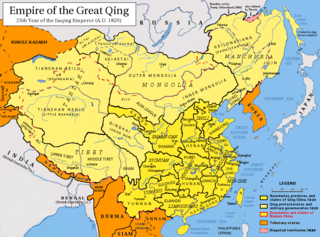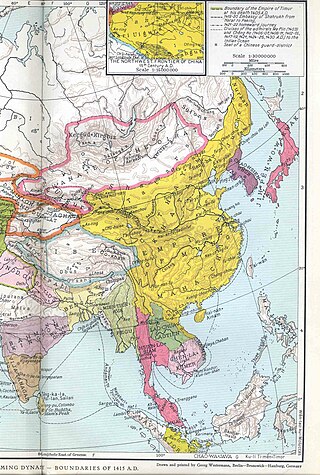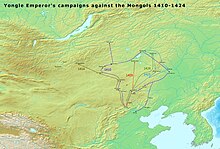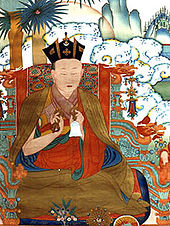
The Dzungar Khanate, also written as the Zunghar Khanate or Junggar Khanate, was an Inner Asian khanate of Oirat Mongol origin. At its greatest extent, it covered an area from southern Siberia in the north to present-day Kyrgyzstan in the south, and from the Great Wall of China in the east to present-day Kazakhstan in the west. The core of the Dzungar Khanate is today part of northern Xinjiang, also called Dzungaria.

Oirats or Oirds, also formerly Eluts and Eleuths, are the westernmost group of the Mongols whose ancestral home is in the Altai region of Siberia, Xinjiang and western Mongolia.
Esen (1407–1454), was a powerful Oirat taishi and the de facto ruler of the Northern Yuan dynasty between 12 September 1453 and 1454. He is best known for capturing the Emperor Yingzong of Ming in 1449 in the Battle of Tumu Fortress and briefly reuniting the Mongol tribes. The Four Oirat reached the peak of their power under his rule.

Moghulistan, also called the Moghul Khanate or the Eastern Chagatai Khanate, was a Mongol breakaway khanate of the Chagatai Khanate and a historical geographic area north of the Tengri Tagh mountain range, on the border of Central Asia and East Asia. That area today includes parts of Kazakhstan, Kyrgyzstan, and northwest Xinjiang, China. The khanate nominally ruled over the area from the mid-14th century until the late 17th century.
Mansur Khan (1482/3–1543), was the last khan of a united Moghulistan from 1503 until his death. From his father Ahmad Alaq, the previous khan, he inherited the eastern parts of Moghulistan proper, the Muslim oasis cities of Yanqi, Bay, and Kuqa, and the Buddhist "Uighur" holdout of Turfan. He also led a jihad of conquest against Oirat Mongol and Chinese territories to the east, including Hami and Dunhuang, and attempted to convert the Kyrgyz to Islam.

Mongolia under Qing rule was the rule of the Manchu-led Qing dynasty of China over the Mongolian Plateau, including the four Outer Mongolian aimags and the six Inner Mongolian aimags from the 17th century to the end of the dynasty. The term "Mongolia" is used here in the broader historical sense, and includes an area much larger than the modern-day state of Mongolia. By the early 1630s Ligdan Khan saw much of his power weakened due to the disunity of the Mongol tribes. He was subsequently defeated by the Later Jin dynasty and died soon afterwards. His son Ejei handed the Yuan imperial seal over to Hong Taiji in 1635, thus ending the rule of the Northern Yuan dynasty in Inner Mongolia. However, the Khalkha Mongols in Outer Mongolia continued to rule until they were overrun by the Dzungar Khanate in 1690, and they submitted to the Qing dynasty in 1691.

The Ming dynasty considered Tibet to be part of the Western Regions. While the Ming dynasty at its height had some degree of influence in Tibet, the exact nature of their relations is under dispute by modern scholars. Analysis of the relationship is further complicated by modern political conflicts and the application of Westphalian sovereignty to a time when the concept did not exist. The Historical Status of China's Tibet, a book published by the People's Republic of China, asserts that the Ming dynasty had unquestioned sovereignty over Tibet by pointing to the Ming court's issuing of various titles to Tibetan leaders, Tibetans' full acceptance of the titles, and a renewal process for successors of these titles that involved traveling to the Ming capital. Scholars in China also argue that Tibet has been an integral part of China since the 13th century and so it was a part of the Ming Empire. However, most scholars outside China, such as Turrell V. Wylie, Melvyn C. Goldstein, and Helmut Hoffman, say that the relationship was one of suzerainty, Ming titles were only nominal, Tibet remained an independent region outside Ming control, and it simply paid tribute until the Jiajing Emperor, who ceased relations with Tibet.

The Northern Yuan was a dynastic regime ruled by the Mongol Borjigin clan based in the Mongolian Plateau. It existed as a rump state after the collapse of the Yuan dynasty in 1368 and lasted until its conquest by the Jurchen-led Later Jin dynasty in 1635. The Northern Yuan dynasty began with the retreat of the Yuan imperial court led by Toghon Temür to the Mongolian steppe. This period featured factional struggles and the often only nominal role of the Great Khan.
The Four Oirat ; also Oirads and formerly Eleuths, alternatively known as the Alliance of the Four Oirat Tribes or the Oirat Confederation, was the confederation of the Oirat tribes which marked the rise of the Western Mongols in the history of the Mongolian Plateau.
The Upper Mongols, also known as the Köke Nuur Mongols or Qinghai Mongols, are ethnic Mongol people of Oirat and Khalkha origin who settled around the Qinghai Lake in so-called Upper Mongolia. As part of the Khoshut Khanate of Qaidam Basin and the Qinghai Lake, they played a major role in Sino–Mongol–Tibetan politics during the 17th and 18th centuries. The Upper Mongols adopted Tibetan dress and jewelry despite still living in the traditional Mongolian ger and writing in the script.
Various nomadic empires, including the Xiongnu, the Xianbei state, the Rouran Khaganate (330–555), the First (552–603) and Second Turkic Khaganates (682–744) and others, ruled the area of present-day Mongolia. The Khitan people, who used a para-Mongolic language, founded an empire known as the Liao dynasty (916–1125), and ruled Mongolia and portions of North China, northern Korea, and the present-day Russian Far East.

The Kumul Khanate was a semi-autonomous feudal Turco-Mongol khanate within the Qing dynasty and then the Republic of China until it was abolished by Xinjiang governor Jin Shuren in 1930. The khanate was located in present-day Hami prefecture of Xinjiang.

The Ming–Turpan conflict were a series of conflicts between the Ming dynasty and Khanate of Moghulistan that erupted due to disputes over borders, trade and internal succession to the throne of Moghulistan.

Kara Del or Qara Del was a Mongol-led kingdom that existed in Qamil or Hami, in present-day Xinjiang. It was founded by the Yuan prince Gunashiri, a descendant of Chagatai Khan, in the late 14th century, and ruled by the Chagatayids thereafter until 1463. From 1380, it began to pay tribute to the Ming dynasty. From 1406, it was governed by Ming under the "Hami Guard" ; however, sometimes it was still under the influence of the Northern Yuan, and the ruler was called the Obedient King under the Jimi system. It was destroyed in 1513 as a result of the wars between the Ming dynasty and the Oirats, as well as dynastic succession struggles. Kara Del means "black chest" in the Old Mongol language.

The Dzungar–Qing Wars were a decades-long series of conflicts that pitted the Dzungar Khanate against the Qing dynasty and its Mongol vassals. Fighting took place over a wide swath of Inner Asia, from present-day central and eastern Mongolia to Tibet, Qinghai, and Xinjiang regions of present-day China. Qing victories ultimately led to the incorporation of Outer Mongolia, Tibet and Xinjiang into the Qing Empire that was to last until the fall of the dynasty in 1911–1912, and the genocide of much of the Dzungar population in the conquered areas.
The division of the Mongol Empire began after Möngke Khan died in 1259 in the siege of Diaoyu Castle with no declared successor, precipitating infighting between members of the Tolui family line for the title of khagan that escalated into the Toluid Civil War. This civil war, along with the Berke–Hulagu war and the subsequent Kaidu–Kublai war, greatly weakened the authority of the great khan over the entirety of the Mongol Empire, and the empire fractured into four khanates: the Golden Horde in Eastern Europe, the Chagatai Khanate in Central Asia, the Ilkhanate in Iran, and the Yuan dynasty in China based in modern-day Beijing – although the Yuan emperors held the nominal title of khagan of the empire.

The Qing dynasty in Inner Asia was the expansion of the Qing dynasty's realm in Inner Asia in the 17th and the 18th century AD, including both Inner Mongolia and Outer Mongolia, both Manchuria and Outer Manchuria, Tibet, Qinghai and Xinjiang.

The Yuan dynasty in Inner Asia was the domination of the Yuan dynasty in Inner Asia in the 13th and the 14th centuries. The Borjigin rulers of the Yuan came from the Mongolian steppe, and the Mongols under Kublai Khan established the Yuan dynasty (1271–1368) based in Khanbaliq. The Yuan was a dynasty that incorporated many aspects of Mongol and Chinese political and military institutions.

Manchuria under Ming rule refers to the domination of the Ming dynasty of China over the greater region of Manchuria, including today's Northeast China and Outer Manchuria. The Ming rule of Manchuria began with its conquest of Manchuria in the late 1380s after the fall of the Mongol-led Yuan dynasty, and reached its peak in the early 15th century with the establishment of the Nurgan Regional Military Commission. With the dissolution of the Nurgan Regional Military Commission the Ming power waned considerably in Manchuria. Starting in the 1580s, Nurhaci, the Jianzhou Jurchen chieftain who had been a Ming vassal, began to take control of most of Manchuria over the next several decades, and in 1616 he established the Later Jin and openly renounced Ming overlordship with the Seven Grievances. The Qing dynasty established by his son Hong Taiji would eventually conquer the Ming and take control of China proper.

This article summarizes the History of the eastern steppe, the eastern third of the Eurasian Steppe, that is, the grasslands of Mongolia and northern China. It is a companion to History of the central steppe and History of the western steppe. Most of its recorded history deals with conflicts between the Han Chinese and the steppe nomads. Most of the sources are Chinese.


















